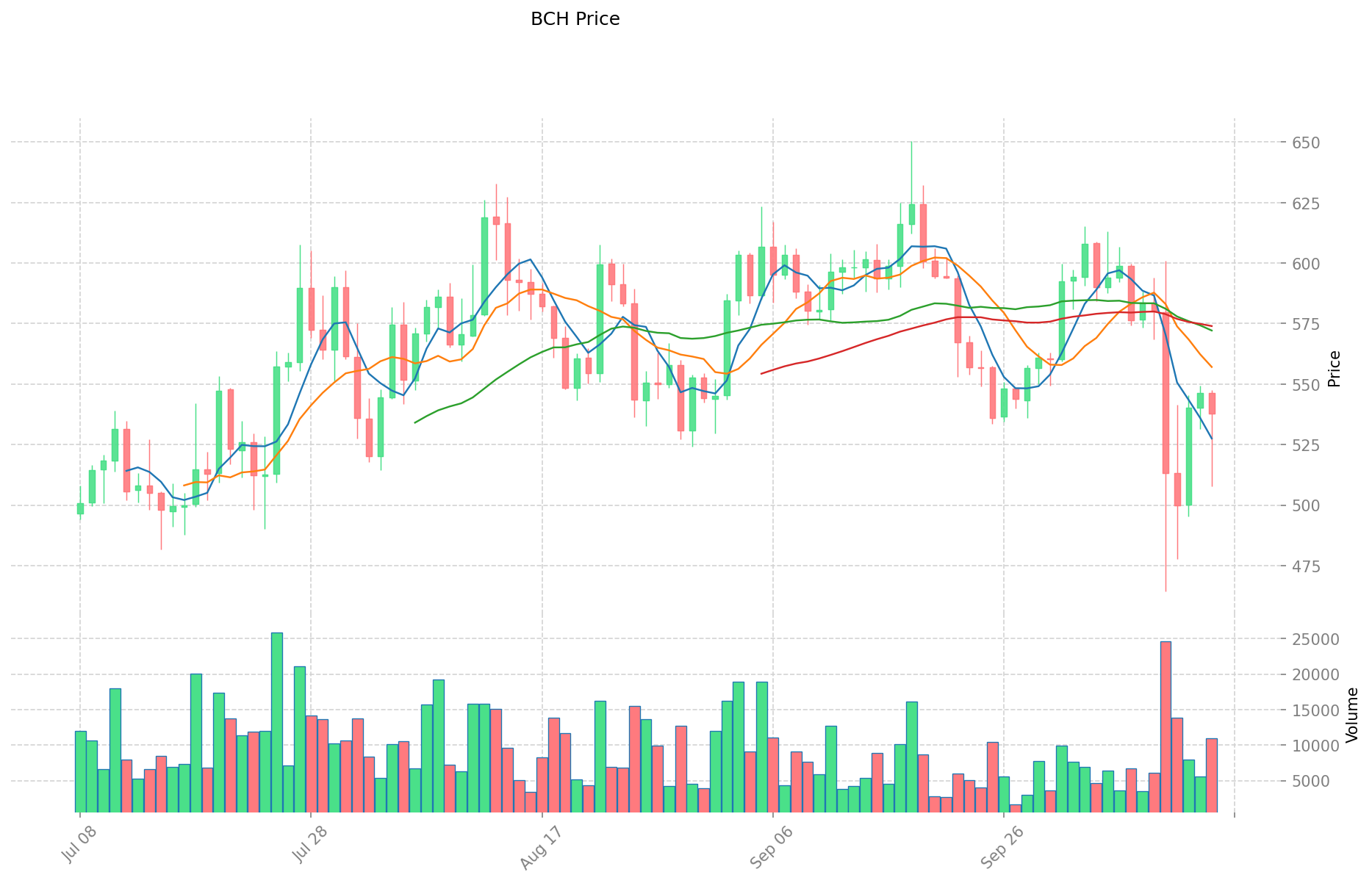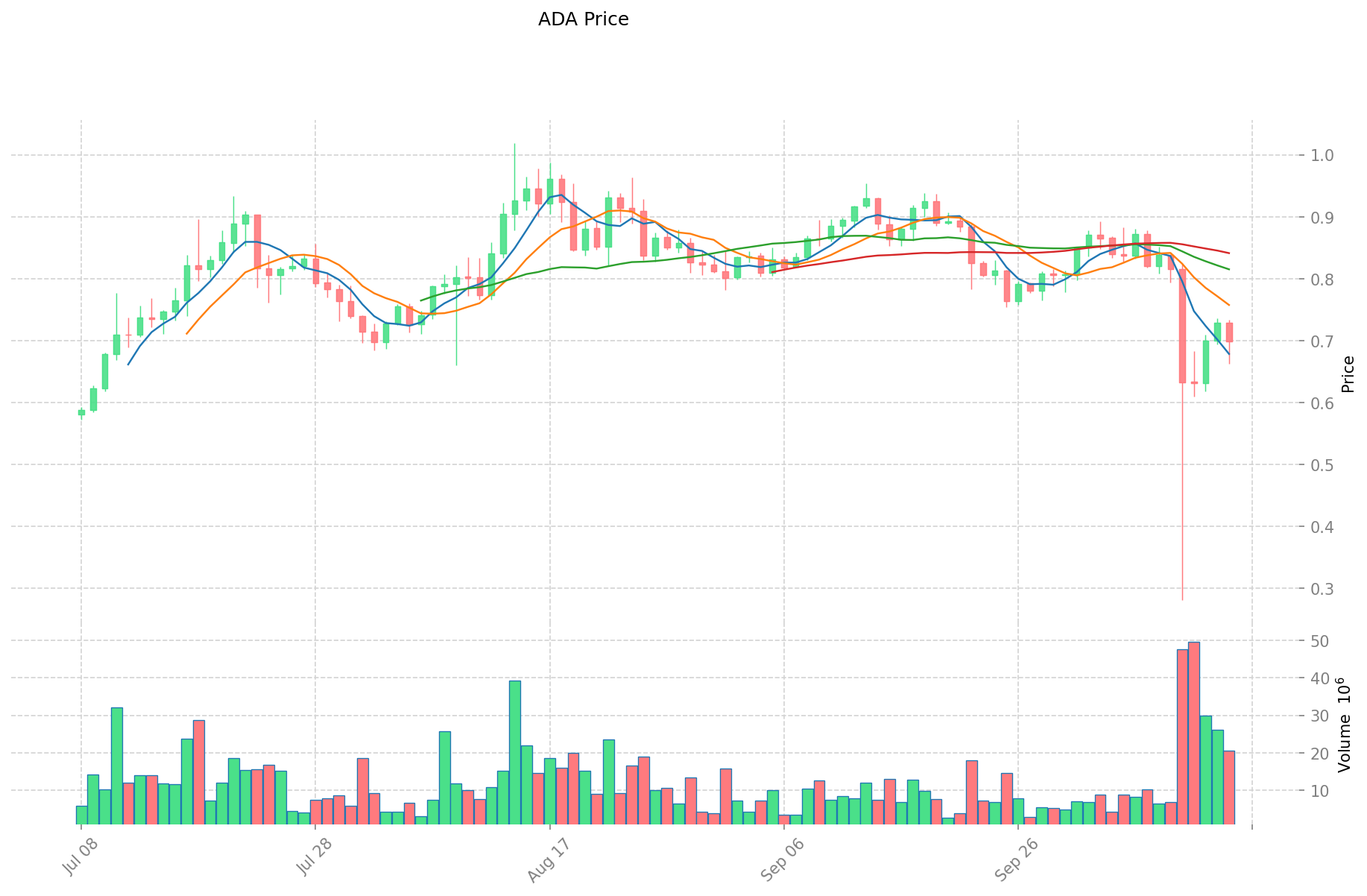BCH vs ADA: Comparing Two Prominent Cryptocurrencies in the Digital Asset Space
Introduction: BCH vs ADA Investment Comparison
In the cryptocurrency market, the comparison between Bitcoin Cash (BCH) and Cardano (ADA) has always been a topic that investors cannot avoid. The two not only show significant differences in market cap ranking, application scenarios, and price performance, but also represent different positioning in the crypto asset space.
Bitcoin Cash (BCH): Since its launch in 2017, BCH has gained market recognition for its focus on on-chain scaling and global adoption.
Cardano (ADA): Introduced in 2017, ADA has been hailed as a technology platform capable of running financial applications used by individuals, organizations, and governments worldwide.
This article will provide a comprehensive analysis of the investment value comparison between BCH and ADA, focusing on historical price trends, supply mechanisms, institutional adoption, technological ecosystems, and future predictions, attempting to answer the question most important to investors:
"Which is the better buy right now?"
I. Price History Comparison and Current Market Status
Bitcoin Cash (BCH) and Cardano (ADA) Historical Price Trends
- 2017: BCH was created through a Bitcoin hard fork, with its price reaching $3,785.82.
- 2021: ADA hit its all-time high of $3.09 due to smart contract implementation.
- Comparative analysis: During the 2022 bear market, BCH dropped from its high of $3,785.82 to a low of $76.93, while ADA declined from $3.09 to $0.2300.
Current Market Situation (2025-10-15)
- BCH current price: $535.74
- ADA current price: $0.6937
- 24-hour trading volume: BCH $5,737,389.15 vs ADA $13,555,358.18
- Market sentiment index (Fear & Greed Index): 34 (Fear)
Click to view real-time prices:
- Check BCH current price Market Price
- Check ADA current price Market Price


BCH vs ADA: Investment Value Analysis
I. Fundamental Comparison of BCH and ADA
Bitcoin Cash (BCH) originated as a fork from Bitcoin in 2017, created to address Bitcoin's scalability issues through larger block sizes. In contrast, Cardano (ADA) was designed as a third-generation blockchain platform developed by Charles Hoskinson, a co-founder of Ethereum, with the aim of solving problems inherent in first and second-generation cryptocurrencies.
II. Core Factors Affecting BCH vs ADA Investment Value
Supply Mechanism Comparison (Tokenomics)
- BCH: Fixed supply of 21 million coins with a halving mechanism similar to Bitcoin
- ADA: Maximum supply of 45 billion tokens with no halving mechanism, designed with a focus on stake-based rewards
- 📌 Historical pattern: BCH follows Bitcoin's deflationary model, while ADA's value is more tied to network adoption and development milestones.
Institutional Adoption and Market Applications
- Institutional holdings: BCH has gained significant traction after being classified as a non-security by the SEC and inclusion in the EDX trading platform backed by Wall Street institutions
- Enterprise adoption: BCH has advantages in the payment sector with faster transaction speeds, while ADA focuses on smart contract functionality and broader blockchain applications
- Regulatory policies: BCH benefits from being recognized as a non-security in the US, while ADA faces regulatory challenges with the SEC potentially classifying it as an unregistered security
Technical Development and Ecosystem Building
- BCH technical upgrades: Enhanced smart contract capabilities that maintain its core payment functionality while expanding use cases
- ADA technical development: Structured development roadmap including Byron (infrastructure), Shelley (decentralization), Goguen (smart contracts), Basho (scalability), and Voltaire (governance)
- Ecosystem comparison: ADA has a more comprehensive ecosystem for DeFi and dApps through its academic-research based approach, while BCH focuses primarily on payment applications
Macroeconomic Factors and Market Cycles
- Performance in inflationary environments: BCH tends to follow Bitcoin's pattern as a potential inflation hedge due to its fixed supply
- Monetary policy impact: Interest rates and USD index fluctuations affect both assets, with BCH potentially behaving more like a commodity
- Geopolitical factors: BCH benefits from cross-border transaction demand due to its payment focus, while ADA's value is more tied to ecosystem development and technological progress
III. 2025-2030 Price Prediction: BCH vs ADA
Short-term Prediction (2025)
- BCH: Conservative $304.551 - $534.3 | Optimistic $534.3 - $609.102
- ADA: Conservative $0.546048 - $0.6912 | Optimistic $0.6912 - $0.877824
Mid-term Prediction (2027)
- BCH may enter a growth phase, with estimated prices ranging from $484.230747 to $975.3790761
- ADA may enter a growth phase, with estimated prices ranging from $0.9107399808 to $1.4242423104
- Key drivers: Institutional capital inflow, ETF, ecosystem development
Long-term Prediction (2030)
- BCH: Base scenario $715.4269592705235 - $1067.80143174705 | Optimistic scenario $1067.80143174705 - $1388.141861271165
- ADA: Base scenario $0.742926582623253 - $1.45671878945736 | Optimistic scenario $1.45671878945736 - $2.097675056818598
Disclaimer: This information is for educational purposes only and should not be considered as financial advice. Cryptocurrency markets are highly volatile and unpredictable. Always conduct your own research before making any investment decisions.
BCH:
| 年份 | 预测最高价 | 预测平均价格 | 预测最低价 | 涨跌幅 |
|---|---|---|---|---|
| 2025 | 609.102 | 534.3 | 304.551 | 0 |
| 2026 | 811.81542 | 571.701 | 445.92678 | 6 |
| 2027 | 975.3790761 | 691.75821 | 484.230747 | 29 |
| 2028 | 916.925507355 | 833.56864305 | 658.5192280095 | 55 |
| 2029 | 1260.3557882916 | 875.2470752025 | 446.376008353275 | 63 |
| 2030 | 1388.141861271165 | 1067.80143174705 | 715.4269592705235 | 99 |
ADA:
| 年份 | 预测最高价 | 预测平均价格 | 预测最低价 | 涨跌幅 |
|---|---|---|---|---|
| 2025 | 0.877824 | 0.6912 | 0.546048 | 0 |
| 2026 | 1.15323264 | 0.784512 | 0.44717184 | 13 |
| 2027 | 1.4242423104 | 0.96887232 | 0.9107399808 | 39 |
| 2028 | 1.591421229216 | 1.1965573152 | 1.07690158368 | 72 |
| 2029 | 1.51944830670672 | 1.393989272208 | 0.89215313421312 | 100 |
| 2030 | 2.097675056818598 | 1.45671878945736 | 0.742926582623253 | 109 |
IV. Investment Strategy Comparison: BCH vs ADA
Long-term vs Short-term Investment Strategies
- BCH: Suitable for investors focused on payment scenarios and deflationary attributes
- ADA: Suitable for investors interested in ecosystem potential and smart contract applications
Risk Management and Asset Allocation
- Conservative investors: BCH: 30% vs ADA: 70%
- Aggressive investors: BCH: 60% vs ADA: 40%
- Hedging tools: Stablecoin allocation, options, cross-currency portfolios
V. Potential Risk Comparison
Market Risks
- BCH: High volatility, correlation with Bitcoin price movements
- ADA: Susceptibility to overall crypto market sentiment, project-specific milestones impact
Technical Risks
- BCH: Scalability, network stability
- ADA: Smart contract vulnerabilities, developmental roadmap delays
Regulatory Risks
- Global regulatory policies' differing impacts on both assets, with BCH currently having a more favorable regulatory status in the US
VI. Conclusion: Which Is the Better Buy?
📌 Investment Value Summary:
- BCH advantages: Non-security classification, institutional adoption, payment-focused use case
- ADA advantages: Comprehensive ecosystem, academic research-based development, smart contract functionality
✅ Investment Advice:
- New investors: Consider a balanced approach with a slight bias towards ADA for its ecosystem potential
- Experienced investors: Evaluate personal risk tolerance and align with either BCH's payment focus or ADA's smart contract capabilities
- Institutional investors: Consider BCH for its regulatory clarity and potential as a digital payment solution
⚠️ Risk Warning: The cryptocurrency market is highly volatile. This article does not constitute investment advice. None
VII. FAQ
Q1: What are the main differences between BCH and ADA? A: BCH is a fork of Bitcoin focused on on-chain scaling and global adoption for payments, while ADA is a technology platform designed for running financial applications. BCH has a fixed supply of 21 million coins, while ADA has a maximum supply of 45 billion tokens. BCH primarily focuses on payment solutions, whereas ADA emphasizes smart contract functionality and broader blockchain applications.
Q2: How do the current market prices of BCH and ADA compare? A: As of 2025-10-15, BCH is priced at $535.74, while ADA is priced at $0.6937. BCH has a higher individual token price, but ADA has a larger 24-hour trading volume of $13,555,358.18 compared to BCH's $5,737,389.15.
Q3: Which cryptocurrency has shown better performance during bear markets? A: During the 2022 bear market, BCH dropped from its all-time high of $3,785.82 to a low of $76.93, while ADA declined from $3.09 to $0.2300. Proportionally, ADA showed slightly better resilience during this period.
Q4: How do institutional adoption and regulatory status differ between BCH and ADA? A: BCH has gained significant institutional traction after being classified as a non-security by the SEC and inclusion in the EDX trading platform backed by Wall Street institutions. ADA, however, faces regulatory challenges with the SEC potentially classifying it as an unregistered security.
Q5: What are the long-term price predictions for BCH and ADA by 2030? A: For BCH, the base scenario predicts a range of $715.43 to $1,067.80, with an optimistic scenario reaching up to $1,388.14. For ADA, the base scenario predicts a range of $0.74 to $1.46, with an optimistic scenario reaching up to $2.10.
Q6: How should investors allocate their portfolio between BCH and ADA? A: Conservative investors might consider allocating 30% to BCH and 70% to ADA, while aggressive investors might prefer 60% BCH and 40% ADA. The exact allocation should depend on individual risk tolerance and investment goals.
Q7: What are the key risks associated with investing in BCH and ADA? A: For BCH, key risks include high volatility, correlation with Bitcoin price movements, and potential scalability issues. For ADA, risks include susceptibility to overall crypto market sentiment, smart contract vulnerabilities, and potential developmental roadmap delays. Both face regulatory risks, although BCH currently has a more favorable regulatory status in the US.
Share
Content